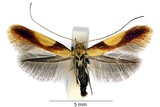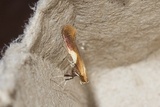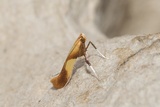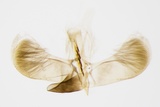Caloptilia robustella Jäckh, 1972 Species
Last modified: Dec. 14, 2024, 11:34 a.m.
A not so common species in Belgium. During the last two decades, the species is spreading. Probably underrecorded, because of the similarity to the related Caloptilia alchimiella.
Details
- Classification
- Family: Gracillariidae > Subfamily: Gracillariinae > Tribus: Gracillariini > Genus: Caloptilia > Species: Caloptilia robustella
- Vernacular names
- Eikensteltmot (NL), New oak slender (EN), Kleine Eichen-Blatttütenmotte (DE)
- First mention in Belgium
- Coenen F. 1981a. Troisième contribution à la connaissance des Microlépidoptères de Belgique. Caloptilia robustella Jäckh, espèce nouvelle pour la faune belge (Lep. Gracillariidae). — Linneana belgica 8: 261–266. On page 261.
- Status
-
Native
Distribution
Imago
Forewings are reddish brown with a conspicuous yellow triangular spot at the middle of the costa. This spot is not prolonged towards the apex. Similar to Caloptilia alchimiella in this species the triangular spot is prolonged towards the apex. For other differences with Caloptilia alchimiella see under that species.
Mine
Very similar to the mine of Caloptilia alchimiella.
See also gracillariidae.net and bladmineerders.be.
Cocoon/pupa
The last instar constructs an oval, silken cocoon on the underside of a leaf. This cocoon is usually more yellowish than the one of Caloptilia alchimiella.
Bionomics
The first instars live in a short gallery at the underside of a leaf, becoming a blotch, and later in 2 or 3 successive cones, rolled down at the top of a lobe. In contrast with Caloptilia alchimiella, this species has also a generation of larvae during May–June.
Hibernating in the pupal stage. The adults come to light.
Flight periods
The adults fly in several ill-defined generations a year from April to November.
Observed on
- Host plant (species):
- Quercus robur
- Host plant (genera):
- Quercus
The larvae feed on Quercus, rarely on Fagus.
Habitat
This species seems to prefer somewhat more xerothermic localities than the related Caloptilia alchimiella.





